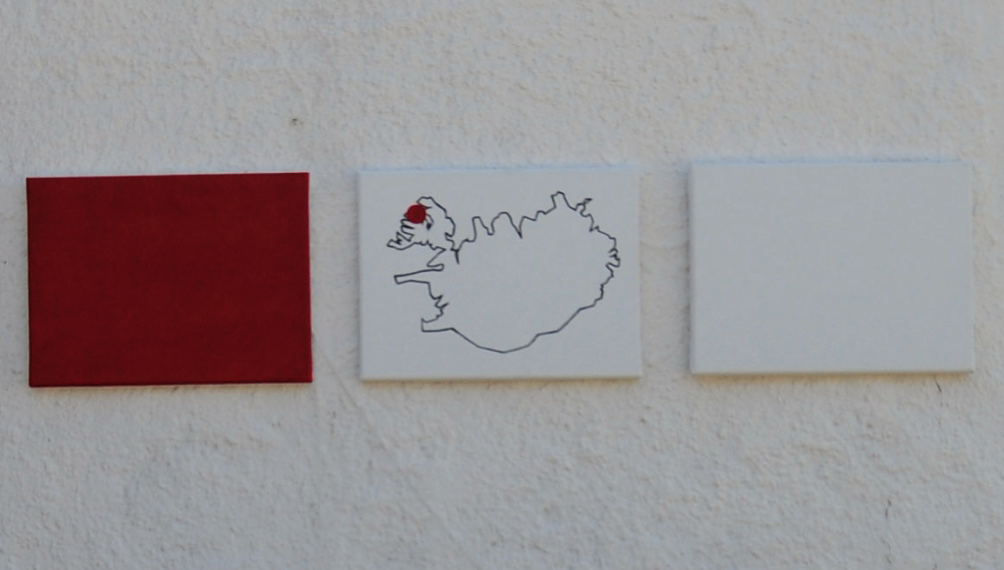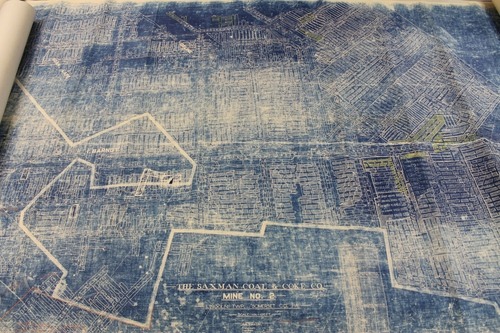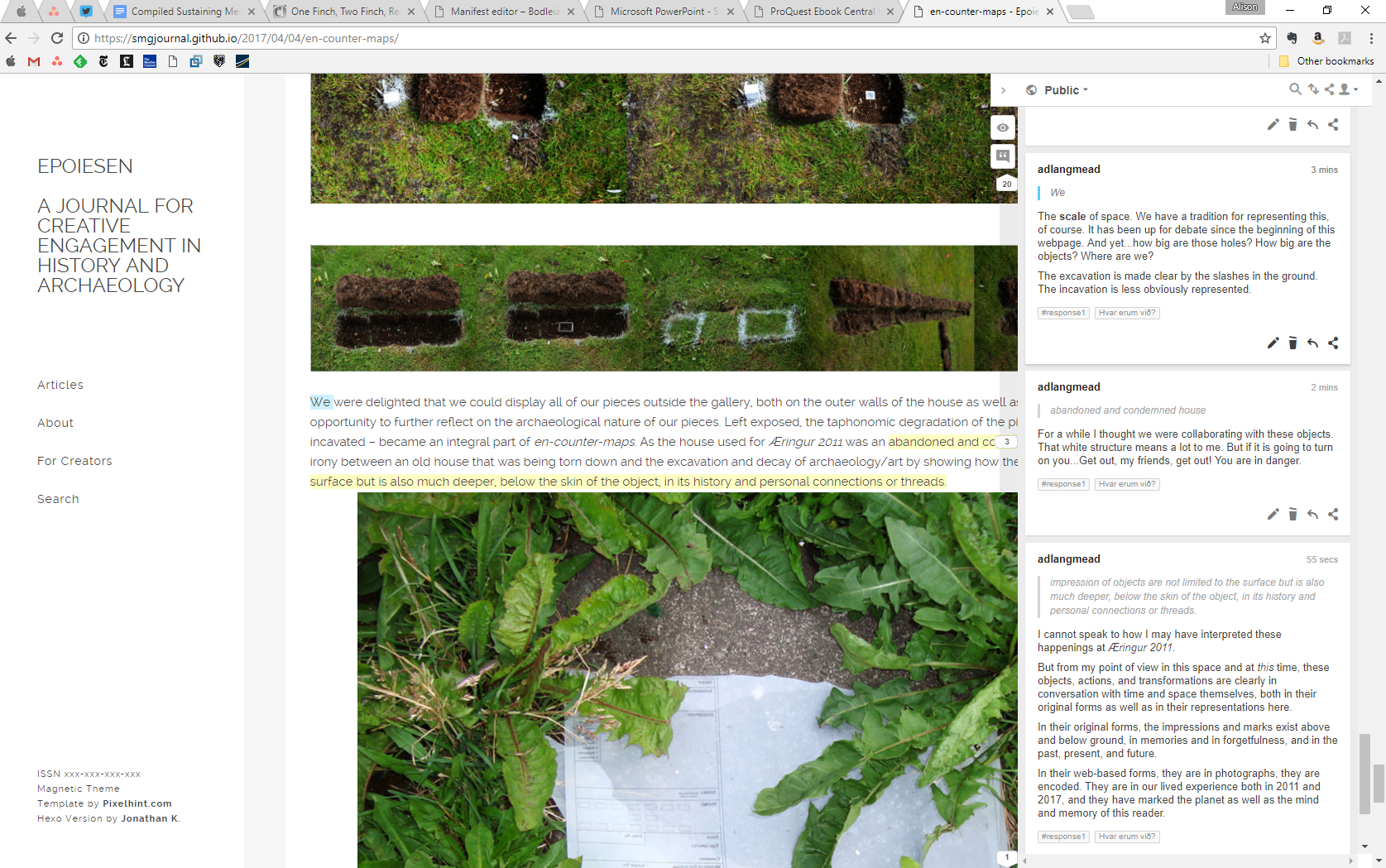en-counter-maps: First Response

editorial note
The response to this piece was done via the Hypothesis annotation layer for en-counter-maps; to see the annotations in context, which is the proper way to read this response, go to en-counter-maps and toggle the Hypothesis arrow. We have aggregated the links below for archival purposes.
Hvar erum við? Where are we, indeed? By these words, ambiguity slides from the text into the very makeup of the landscape represented by this photograph. A quick trip to Google Translate helps me find a bit of purchase on what I am seeing, and situates this piece textually in Iceland--something suggested, but not strictly disambiguated, by the header image.
Returning here, having finished the piece, I find that this image encapsulates for me the entirety of the story that is to come--the inverse of ambiguity.
It becomes clear to me through this step back that the canvas of the white structure's walls are in a state of becoming.
Instead of the brown gashes of the trenches, chalk scores the earth the way that old police dramas demarcated dead bodies.
Ferdy on Films
The chalk lines are now just in a state of becoming. A human appears. The technology used to create the patterns we now expect become visible. The human appears almost as an interlper, as the objects have as yet taken center stage in this system.
In the second image of this sequence, the human becomes a mere shadow. A shadow whose originating object, for a while, eluded me. The shadow of the photographer that is made on the roof melds with the shadow of the white structure on the ground to create the impression a panoptic prison tower has been inserted into our narrative. Angles are seen, all jutting out, allowing for a sweeping view of the terrain.
It is a prison guard's point of view, but it is also a cartographer's. The question of scale both in the form of a silhouette and in the form of an inquirer's standpoint arises.
By the end of this sequence, distant crowds gather and time speeds on (backwards or forwards, we do not know) in a time-lapse photograph taken--we assume--within the white structure?
Later, I return to this time-lapse image, thinking..."The white structure is condemned."
I am lost in the images. The text moves me to another interpretive paradigm. I do not like it. I was content, lost in my own self-centered reflections. Ambiguity is uncomfortable to me, it would appear, only until I start my own sense-making.
Later, I return, having been able to see the surface better, re-struck by its formal similarities to old-fashioned architectural blueprints at a distance. It is, among other things, a question of scale and expectations.

Painting Shows Pinterest: Bob Ross
Does the original purpose of the trowel change things materially? I feel that it does in this instance for the humans involved. The repurposing of tools from their profession within the context of this artistic expression is meaningful. From the point of view of the trowel, maybe not as much.
I suddenly wish these annotations were a real conversation.
My experience with this formal construction is different.
Dreamcatcher Wallpaper
I am oriented, as if using a map. I know my scale. I am comfortable with my ambiguity.
Not being an archaeologist myself --I am an art historian by training--I choose to combine the (for me) uncomfortable, insistent not-knowing of the piece as it unfolds with the authors' assertion that their artistic interventions are about the nature of archaeology--together, this suggests an archaeology that does not, or cannot, ever see the "whole picture." While a map might constitute seeing this putative "whole," a counter-map would be the inverse.
This makes a satisfying sort of empathetic sense. I could imagine finding something in an excavation that is clearly true and present, but whose crucial context is engulfed by the expanses of unexcavated land nearby.
 Saxman No. 2 Mine map, CONSOL Energy, Inc. Mine Maps and Records Collection, AIS.1991.16, Archives Service Center, University of Pittsburgh
Saxman No. 2 Mine map, CONSOL Energy, Inc. Mine Maps and Records Collection, AIS.1991.16, Archives Service Center, University of PittsburghThe door to our dear white structure also appears in a state of decay. Why are we suddenly stopped at the side of the road? In this piece about maps, I feel decidedly unmoored.
And yet, in the corner of my eye, red. Red and the shape of Iceland. Iceland with a red dot. This is where we are.
All of these reflections could be "just me." It could all also be a question of scale.
In retrospect, I realize that the artists were being literal in their production of archaeological artifacts. Not ambiguous in the least. I find myself, again, caught up in my own story.
The image below shows the "mess" of the work involved in the original happening. The threads, the piles, the maps. I now also see this as progress, as moving towards a conclusion.
The map now posted on the shady side of the white structure, ambiguously part of the 1913 Map of 2011 Bolungarvík work, shows a region shattered by lines of red thread, each drawing attention to particular details of the landscape, a bit like drawing out blood. Pins, details, threads. Somewhere between an old-fashioned collection of butterflies, each impaled with a pin and a "crazy wall" of a contemporary (here comes the crime again) CSI drama, lies this diagram of exploding details.
 Oxford Museum of Natural History
Oxford Museum of Natural History  Esquire. Also, please feel free to visit the Crazy Walls Tumblr.
Esquire. Also, please feel free to visit the Crazy Walls Tumblr.The crispness of the shadow on the side wall caused by the paper hanging in the air is notable. I find myself assuming this is late in the day. The power of the low sun in Iceland must be intense.
The artists' plan for a future excavation is presaged by past actions. The scale of time inherent in this piece--and perhaps by extension, archaeology--arises.
Cartographic maps are like that too, though. I suppose I might be wrong.
Everyone's ur-visualization comes to mind.
 Charles Minard's map of Napoleon's Russian campaign of 1812
Charles Minard's map of Napoleon's Russian campaign of 1812Showing both space and time together as abstractions, Minard also conflates these two properties, compromising perfect data clarity on either.
The excavation is made clear by the slashes in the ground. The incavation is less obviously represented.
#
But from my point of view in this space and at this time, these objects, actions, and transformations are clearly in conversation with time and space themselves, both in their original forms as well as in their representations here.
In their original forms, the impressions and marks exist above and below ground, in memories and in forgetfulness, and in the past, present, and future.
In their web-based forms, they are in photographs, they are encoded. They are in our lived experience both in 2011 and 2017, and they have marked the planet as well as the mind and memory of this reader.
 My workspace. Right now.
My workspace. Right now.Cover Image "Image taken from page 239 of 'The Seasons, and the Castle of Indolence ... With a biographical and critical introduction by A. Cunningham, etc'" British Library
Masthead Image Pálsson and Aldred.
